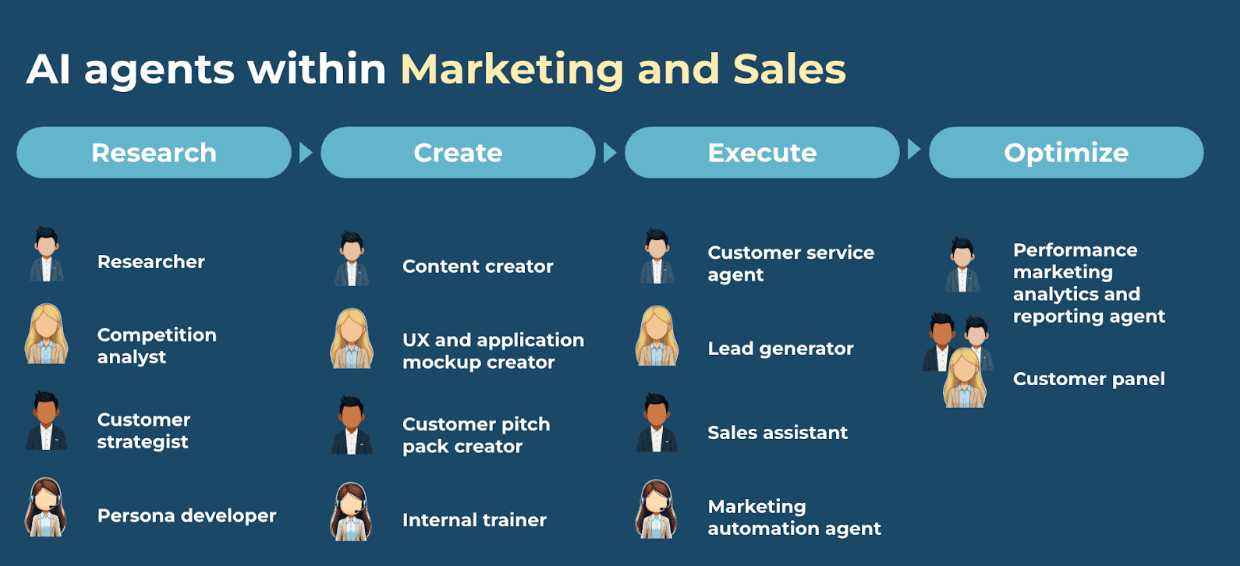
How AI Agents navigate the chaos of Marketing as our Digital colleagues
Modern marketing is chaotic, with fragmented data across multiple systems. This article explains how digital colleagues (AI agents) can navigate this mess, connect disparate data sources in real time, and enable human teams to focus on creativity rather than data integration.
How AI Agents navigate the chaos of Marketing as our Digital colleagues
Modern marketing isn’t short on tools - or on data, or smart strategies and ambition. It’s short on specialized competence and time. Most teams aim for data-driven workflows, real-time insights, proactive orchestration and personalization at scale, yet end up drowning in tasks, fragmented dashboards, and manual optimization. Digital colleagues don’t wait for perfect data models, they work through the mess. They interpret, connect, and act across siloed systems, making coherence the new superpower.

“ Most enterprises are still trying to fix their data before they fix their decisions. It’s like waiting for perfect weather before setting sail. Digital colleagues don’t wait, they navigate through the fog, connect what’s already there, and deliver value through the mess, not after it. ”
That’s the new growth advantage: not collecting more data, but finally connecting the dots you already have.
Context and setup: the problem isn’t data scarcity, it’s fractured context
Automation made marketing faster, not smarter. Every system optimizes its own slice of the customer journey; CRM here, ad platform there, analytics somewhere else, leaving teams stuck stitching insights by hand.
You’ll recognize the daily pattern:
- Customer data spread across six platforms
- Campaign results that never match sales figures
- Marketing spend justified by three different dashboards
- Endless “alignment meetings” trying to explain what’s already happened
Digital colleagues are built for this chaos. They don’t demand clean data; they work with what’s there, cross-referencing, interpreting, and reasoning across systems in real time.
Breakthroughs don't come from perfect integration, but from colleagues that make data usable as they work. They navigate broken schemas, incomplete fields, and conflicting truth sources, and still move the business forward.
One client said, "we stopped waiting for data readiness and started using digital colleagues that were ready for data imperfection.”
From assistants to cross-system colleagues
Traditional automation executes within a process. Digital colleagues move between them, connecting CRM records, campaign data, and customer interactions without rewriting the stack.
In practice:
- A research colleague surfaces insights from reports, social feeds, and surveys, even if formats don’t match.
- A creation colleague builds campaigns using fragmented brand assets and partial performance data.
- A sales colleague links lead data from Salesforce with meeting transcripts to find real intent.
- A performance colleague reconciles metrics across systems, identifying what’s signal and what’s noise.
Each colleague turns fragmentation into fluency. They don’t eliminate complexity; they make it work for you. One client said: “We used to run integration projects. Now we just onboard colleagues who already speak multiple data dialects.”
The connected growth fabric
When digital colleagues work across systems, something powerful happens: the enterprise starts seeing itself clearly for the first time. Insights travel. Teams stop waiting for alignment. Fragmented truth becomes functional intelligence.
Digital colleagues create:
- Translation between tools and teams, bridging CRM, MA, CMS, and analytics without middleware.
- Connection between datasets; linking customer behavior with sales context in real time.
- Continuity across workflows, insights captured in one stage feed naturally into the next.
- Clarity without replatforming, surfacing what matters across messy realities.
- New data sets from actually looking at each transaction and interpreting them
Once the systems start talking, something unexpected happens, people do too. This is the compounding effect of reusable growth: not just reuse, but relevance across complexity.

“ Most teams don’t need more dashboards - and rarely more data. They need more dialogue, with each other and with their digital colleagues. That’s when creativity compounds instead of getting lost in reports. ”
Human creativity in a fragmented world
Digital colleagues don’t replace creative work, they enable it. When they handle the stitching and context-building, human teams can focus on what still can’t be automated: judgment, storytelling, and invention. How humans and digital colleagues co-manage fragmentation:
- Humans ask questions, digital colleagues surface usable context.
- Humans test ideas, digital colleagues validate across systems.
- Humans improvise, digital colleagues keep every source in sync.
It’s a partnership: digital colleagues maintain coherence; humans create meaning. That’s how modern marketing finally scales, not by cleaning data, but by collaborating across it.
From use case to outcome: how digital colleagues already work
The shift is already happening inside marketing and sales. Where traditional tools delivered isolated outputs, digital colleagues now own continuous roles across the value chain: from research to creation, execution, and optimization.Here’s what that looks like in practice:
- Research: A competition analyst colleague scans new entrants, campaign performance, and market chatter, turning unstructured signals into opportunity maps before the Monday meeting even starts.
- Create: A content creator colleague repurposes existing assets into new campaigns, while a UX mockup builder turns briefs into live prototypes connected to performance data
- Execute: A sales assistant colleague syncs CRM data with outreach sequences, spotting real buying intent across channels, while a marketing automation agent tests and tweaks email cadences in real time.
- Optimize: A performance colleague reconciles analytics from multiple systems to show which segments compound, while a customer panel colleague interprets feedback at scale, helping teams validate ideas earlier and feed insight into every step of the process, from research and content creation to campaign execution, by simulating customer feedback in real time.
One client described it simply: “We didn’t add tools, we added colleagues who already understood our mess.”

These aren’t copilots or chatbots. They’re accountable agents that deliver outcomes, learn through imperfection, and expand what human teams can achieve together. This is where reusable growth gets real, when digital colleagues turn every disconnected action into part of a living, learning marketing system.
What marketing and sales teams should
Stop chasing the mythical “unified data model” or the promise of “one system to rule them all.” That dream has burned through more budgets than banner ads ever did. The new play is simpler: start enabling digital colleagues that can reason across the systems you already have; imperfect, overlapping, and very human.
Here’s how to start turning fragmentation into flow:
- Map the fractures, not the platforms: Pick one workflow where marketing and sales lose the thread; campaign ROI, lead scoring, customer segmentation. Instead of listing every data source, trace how decisions actually move (or stall) between teams.
- Assign a digital colleague to the chaos: Deploy a colleague that can connect CRM, analytics, and ad data in real time, not by rewriting schemas, but by interpreting what’s already there. The goal isn’t cleaner data; it’s faster learning.
- Let it learn in the wild: Don’t isolate your colleague in a sandbox or pilot. Let it reason through live imperfections, feedback loops, and messy inputs. That’s how it builds context no data warehouse ever could.
- Redefine what “performance” means: Measure how many insights travel between systems, how often decisions improve without escalation, and how fast new context is applied. That’s the new conversion metric, decision velocity.
In the end, coherence isn’t a data project. It’s a collaboration model. Digital colleagues don’t replace teams; they make the system intelligent enough to move as one.